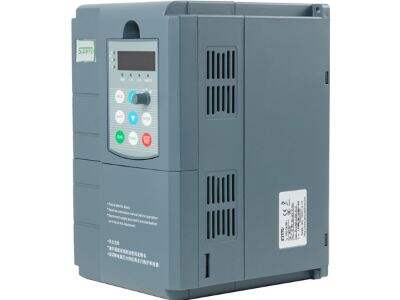Common machines such as cranes, elevators, and conveyor belts use special braking resistors. These are key parts of how these machines work. What is a braking resistor, and how does one choose the correct braking resistor for their application? This guide will explain this important component and how to choose the right braking resistor for your SANYU motors.
What is a Braking Resistor?
The braking resistor is a special electrical component used to slow down or stop the motor safely. At work, when a motor is at work and doing a job, it makes energy.” When the motor stops working, this energy has to be released or let go of. If this energy is not handled properly, it can lead to the damage of the motor or indeed, hazardous events in relation to people in the proximity.
The benefit of the braking resistor is that it provides a destination for the extra electrical energy. This process smoothest the deceleration of the motor. One method is called electrical braking. It is also a safe and effective way to decelerate a motor quickly, while also avoiding any damage to the facility or persons.
Feature Of A Braking Resistor
A braking resistor may be necessary if the motor frequently starts and stops. This is especially critical if halting the motor immediately could be hazardous. For instance, if a heavy object is lifted or moved, a sudden halt can result in accidents.
Here is a list of typical motors that need braking resistor for vfd:
Ask questions about the type of power: Elevator motors: These motors move people and goods up and down.
-- Cranes motors: These motors move heavy objects in construction or shipping.
Conveyor belt motors: These move goods or items along a belt (in factories, for instance).
Materials handling motors: These motors assist in the movement or storage of diverse materials.
If your motor also has a large fan or another component that could cause it to spin after it has been turned off, it can also need a braking resistor. This allows the motor to stop safely and rapidly.
Braking Resistor Selection Guide
There are several crucial considerations that you should keep in mind when choosing a inverter braking resistor for your SANYU motor. Here’s what to keep in mind:
Motor voltage: This indicates the amount of electrical energy (voltage) which is required by the motor to function.
Max current draw: This tells you how much electrical energy the motor consumes at brim.
Duty cycle: This is the amount of stops and starts that the motor experiences in use.
Ambient Temperature: The temperature of the air around the motor.
Area for installation: You also have to make sure that there is adequate area to properly install the braking resistor.
Your SANYU sales representative will assist you in providing a better understanding of these factors in order to find a braking resistor that fits your exact needs.
How To Determine Size of Braking Resistor
Identify how big it needs to be: Once you’ve determined which braking resistor you want, the next task is to figure out how large it needs to be. To accomplish this, you will require some crucial details about the motor. In particular, what you need to understand is the motor's voltage, maximum current draw, how frequently it starts and stops, and the temperature of the environment surrounding it.
The braking resistor size can be calculated with this formula:
(Resistance (ohms) = (Motor voltage)2 2 × Maximum current draw × Duty cycle)
This is how you do allow to calculate the resistance that you will need for your braking resistor. This value allows you to select the braking resistor with the required wattage and resistance. Based on your calculations, this choice can be made through your SANYU sales representative.
Installation andMaintenance of Your Braking Resistor
Making sure of proper Installation and Maintenance of your braking resistor is critical in ensuring their proper gym long functional ability. Here are best practices to lean into:
Consult the installation steps provided by SANYU or the manufacturer of the braking resistor. This way you will be sure it is configured properly.
Place the braking resistor in a location that allows for good air flow and is cool. This keeps it from overheating as it works.
Make sure to use the right size wires with the proper connections. This low energy loss keeps the motors running smoothly.
Inspect the braking resistor at regular intervals for cracks, burnt portions, and loose connections. Detecting these at an early stage could help prevent bigger issues.
Visualize the condition of the components, if find any damage, replace that immediately. This protects your motor from damage and prevents accidental hazards.
Using these best practices can help you maximize the performance of your SANYU braking resistor and keep these components working safely for years to come.
Conclusion
That being said, a braking resistor is mainly a component used to safely and efficiently decelerate a motor. Therefore, by choosing the appropriate braking resistor for your SANYU motor, properly sizing it, and following sound installation and maintenance practices, you can ensure that your motor operates safely and reliably. Ask your SANYU sales representative for assistance with selecting a braking resistor for your SANYU motor. They can help you out with expert advice and will certainly make sure you have the proper parts for your needs.

 EN
EN
 AR
AR
 BG
BG
 HR
HR
 CS
CS
 DA
DA
 NL
NL
 FI
FI
 FR
FR
 DE
DE
 EL
EL
 HI
HI
 IT
IT
 JA
JA
 KO
KO
 NO
NO
 PL
PL
 PT
PT
 RO
RO
 RU
RU
 ES
ES
 SV
SV
 CA
CA
 TL
TL
 IW
IW
 ID
ID
 LV
LV
 LT
LT
 SR
SR
 SK
SK
 SL
SL
 UK
UK
 VI
VI
 SQ
SQ
 GL
GL
 HU
HU
 MT
MT
 TH
TH
 TR
TR
 MS
MS


